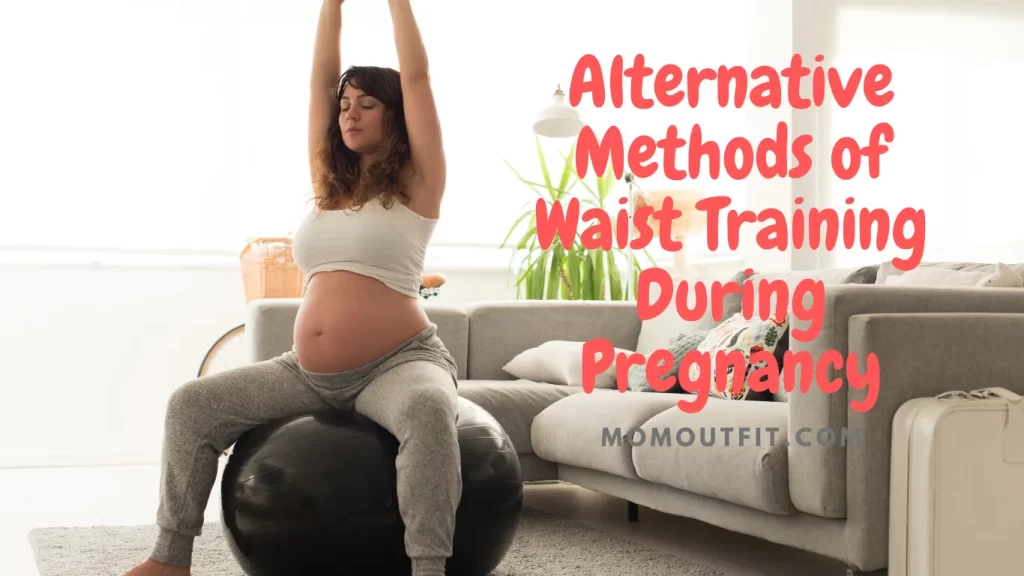Is it safe to wear a waist trainer while pregnant? – I am here to discuss the safety of wearing a waist trainer while pregnant. Also, you will get helpful tips for using a waist trainer during pregnancy.
Waist training is a popular trend for anyone to achieve a smaller waistline. Significantly, pregnant women focus on this subject to shape the waist and abdomen into a slenderer appearance.
It involves wearing a tight-fitting waist cincher or corset for an extended period. However, whether it is okay to wear a waist trainer while pregnant has been a topic of concern for many expecting mothers.
Indeed, pregnancy is a memorable time in a woman’s life. Throughout this period, the body undergoes numerous changes that affect the mother’s and baby’s overall health and comfort. Thus, the use of waist trainers may raise questions about their safety and impact on the developing fetus.
I will share valuable insights on waist training regardless of whether you are a first-time mother or have been through pregnancy. Also, you will learn some alternative methods to help you achieve a healthy and comfortable pregnancy.

Notes on Waist Trainer Usages
Some claim that waist training provides numerous benefits, including improved posture and support for the lower back. Alternatively, others argue that it poses significant risks to both mother and baby. That’s why you should know both pros and cons. For better help, I have added insights from medical professionals to help women choose waist trainers.
How Does a Waist Trainer Work?
A waist trainer is a tight-fitting garment that shapes the waist and abdomen. It is usually made of flexible and durable materials, like latex, spandex, or neoprene. Hence, you can find them in various sizes and shapes. The waist trainer is worn around the waist and fastened with hooks, laces, or zippers.
The working mechanism of waist training is based on compression and compression therapy. The tight-fitting nature of the waist trainer applies pressure to the abdominal area. Then it compresses the internal organs and reshapes the waist over time. This pressure is intended to support the lower back and improve posture. Besides, it may help in reducing the appearance of a bulging belly.
It is important to note that waist training should never be worn too tightly. It can restrict breathing and reduce blood and oxygen flow to the organs, especially the uterus, and baby. It is also crucial to consult a doctor before starting a waist training regimen during pregnancy.
Here is a video on “is it safe to wear waist trainers while pregnant?”
The Benefits of Waist Training During Pregnancy
Of course, there are concerns surrounding waist training during pregnancy. Still, you will have multiple potential benefits that you will really love. Some of the benefits of waist training during pregnancy are:
- Improved posture: During pregnancy, a woman’s center of gravity shifts leading to back pain and discomfort. But wearing a waist trainer can improve posture and reduce the chance of back aches.
- Reduced back pain: Wearing a waist trainer during pregnancy can help alleviate lower back pain. This pain is a common complaint among expectant mothers. But the structure of a waist trainer can distribute the body weight evenly. As a result, you will feel less stress in the lower back.
- Supports the lower back: The pressure applied by the waist-trainer is intended to provide support to the lower back and alleviate discomfort caused by weight shifting during pregnancy.
- Promotes better digestion: Pregnancy can lead to digestive issues such as bloating and constipation. Some women believe that the compression provided by the waist trainer can improve digestion by reducing bloating and supporting the internal organs.
- Shaped and toned waistline: If you wear a waistband, you can maintain a shaped and toned waistline. The waist trainer can help keep the abdominal muscles tight. Likewise, it can prevent the skin from stretching too much and cause stretch marks.

The Risks of Waist Trainers During Pregnancy
There are also significant risks associated with this practice that you should not ignore. Some of the risks of waist training during pregnancy are:
- Reduced circulation: Wearing an extremely tight waist trainer can restrict blood flow. It may reduce circulation to the lower abdomen. As a result, it posts adverse effects on the developing fetus. This reduced circulation can also lead to feelings of dizziness, nausea, and discomfort for the mother.
- Restriction of baby’s growth: If you wear a too-tight waist trainer, you can restrict the baby’s growth by limiting the amount of space available in the uterus. It leads to decreased fetal movement causing harm to the developing fetus.

- Reduced oxygen supply to the baby: The compression applied by the waist-trainer can restrict breathing. Also, it can reduce the flow of oxygen and blood to the uterus and baby. It leads to a decrease in the oxygen supply to the baby and potentially increases the risk of preterm labor.
- Increased risk of preterm labor: Using waistbands during pregnancy can also increase the risk of preterm labor. The tightness of the waist shaper can put pressure on the uterus. Afterward, you may face premature contractions and an increased risk of preterm labor.
- Discomfort: You may feel discomfort due to the trainer’s tight fit and restriction of movement. Consequently, you may have feelings of claustrophobia and face difficulty breathing and moving freely.
Alternative Methods of Waist Training During Pregnancy
Some alternative methods are available to provide similar benefits without the associated risks. Here are some alternative methods of waist training during pregnancy:
- Good Posture: Maintaining good posture throughout pregnancy can help to reduce back pain and discomfort. Women are encouraged to stand tall, with their shoulders back, and heads held high. In this way, they can correct the stress on their back.
- Maternity support belts: Maternity belts or bands are specially designed to provide support and comfort to the lower back and abdomen during pregnancy. They are adjustable and made of soft and flexible materials. So, you can wear them throughout the day to alleviate back pain and improve posture.
- Massage and chiropractic care: Massage and chiropractic care can reduce lower back pain and improve posture during pregnancy. Massage can help improve circulation and reduce muscle tension. On the other hand, chiropractic care can help align the spine and reduce the strain on the lower back.
- Prenatal Yoga: Prenatal yoga is a gentle exercise designed to maintain physical and emotional well-being during pregnancy. It can help to improve posture, alleviate back pain, and reduce stress.
- Pelvic Floor Exercises: Pelvic floor exercises are designed to strengthen the pelvic floor muscles. It can support the uterus and reduce the risk of preterm labor.
- Regular Exercise: Regular exercises, such as walking, swimming, or prenatal fitness classes, can keep the body strong and healthy. It can also enhance posture and alleviate back pain.
What Are the Opinions of Medical Professionals on Waist training During Pregnancy?
Many medical professionals do not recommend wearing a waist trainer during pregnancy for the potential risks linked to its use. The American College of Obstetricians and Gynecologists (ACOG) states that restrictive clothing, including waist trainers, can interfere with the growth and development of the fetus. They can invite potential health problems for both mother and baby.
Obstetricians and midwives also caution against the use of waist trainers during pregnancy. Because the compression applied by the garment can reduce the flow of oxygen and blood to the uterus and baby. Again, the tight-fitting nature of the waist trainer can put unnecessary stress on the uterus and potentially increase the risk of preterm labor.
Pregnant or mother-to-be women are encouraged to seek alternative methods of support. Also, they should consult with their doctor for guidance and recommendations.
Factors to Consider Before Wearing a Waist Trainer During Pregnancy
Before wearing a waist trainer during pregnancy, you should consider several factors. These factors include:
- Consultation with a doctor: It is crucial to consult a doctor before starting any new exercise or clothing regimen during pregnancy. Especially if it involves the use of waist trainers. As well, the doctor can assess the individual’s specific needs. They may provide personalized suggestions to maintain a healthy and comfortable pregnancy.
- Comfort: It is essential to ensure that the waist trainer is comfortable. It should not cause any discomfort or restriction of movement. It should not be too tight and allow regular breathing and movement.
- Fit: The waist trainer should fit properly and not be too tight. It should not restrict blood flow or reduce circulation to the lower abdomen. Also, you must ensure that the selected waist trainer does not cause any pressure on the uterus or restrict the baby’s growth.
- Material: The Spanx should be made of a soft, breathable material that will not irritate the skin or cause discomfort. The material should be safe for mothers and not cause any harm to the developing fetus.
- Length of wear: You should set a time to wear the waist trainer daily. Also, try to avoid wearing it for extended periods. I do not suggest you wear a waist trainer when sleeping or engaging in physical activity.
How to Choose the Right Waist Trainer for Pregnancy?
Do you want to buy a waist trainer for your motherhood? Then, you should consider some factors to ensure it is safe and comfortable.
Here are some tips on how to choose the right waist trainer for pregnancy:
- Consult with a doctor: It is crucial to consult before starting any new exercise or clothing, especially if it involves using waist trainers. The doctor can assess the individual’s specific needs. Then, they can provide personalized recommendations to maintain a healthy and happy pregnancy.
- Look for maternity waist trainers: The waist trainers should have a design to provide sufficient support and comfort.
- Choose the right size: You should select the correct size waist trainer to ensure a comfortable fit. It should not be too tight nor too loose. Again, it should allow for regular breathing and movement. You should ensure that the selected one does not cause any pressure on the uterus or restrict the baby’s growth.
- Check the material: The materials for waist trainers are soft, breathable, and safe for use during pregnancy. Avoid waist trainers made of materials causing irritation or discomfort. For example, they can be made of rubber or latex.
- Consider flexible options: Find waist trainers with adjustable straps or those you can adjust as the body changes during pregnancy. It will allow for a comfortable and customizable fit as the body changes.
How Long Can You Wear a Waist Trainer While Pregnant?
Wearing a waist trainer while pregnant is generally considered dangerous due to the high compression it creates around the midsection. It can cause health problems for both the mother and the baby. It is advised to stop wearing a waist trainer immediately after discovering you are pregnant.
However, some sources suggest that wearing a waist trainer during pregnancy might be possible but with caution. According to Health Wearables, you can use a waist trainer during pregnancy for a few hours at a time. But you should ensure it is not too tight and stop if you experience any pain or discomfort.
After giving birth, it is important to allow your body time to heal before wearing a waist trainer. Generally, it is recommended to wait at least 4-6 weeks before using a waist trainer or engaging in vigorous exercise activity. Some sources suggest waiting at least 6-8 weeks before starting to wear a waist trainer after giving birth.
When you do start wearing a waist trainer after giving birth, wear it for a few hours at a time and not overnight to avoid back pain and other health problems. Gradually increase the amount of time you wear it each day until you’re up to wearing it for 8 hours a day. Then you can start wearing it overnight if desired.
Frequently Asked Questions
- Is it safe to wear Spanx during pregnancy?
- Many people recommend not wearing Spanx or any shapewear during pregnancy. It can restrict the baby’s movement and interfere with the growth and development of the uterus.
- How is a maternity waist trainer different than a regular waist trainer?
- Maternity waist trainers support the growing belly. You can adjust them to the changing body shape during pregnancy. But regular waist trainers can only shape the body and help lose weight.
- Is a maternity waist trainer the same thing as compression clothing?
- Maternity waist trainers and compression clothing are not the same. But they can offer support for the growing belly. Compression clothing is usually recommended for medical purposes, such as improving blood circulation or swelling.
- Is it safe to wear shapewear while pregnant?
- You may consider it less safe as it can restrict blood flow and interfere with baby growth.
- Waist trainer vs. shapewear
- Waist trainer and shapewear are quite similar but not the same. The first ones are designed to cinch and shape the waist. But, the latter ones can smooth and contour the body.
- Is it safe to wear waist trainers during the first trimester?
- It can be both safe and unsafe to wear waist trainers during any stage of pregnancy. It helps in maintaining the correct shape of the body. Similarly, it can restrict the baby’s movement and growth.
- Can wearing a waist trainer cause a miscarriage?
- Wearing a waist trainer during pregnancy can increase the risk of miscarriage. So it is not recommended. Could you read this article to know more about it?
- What happens if you waist train while pregnant?
- It can restrict the baby’s movement and growth and cause discomfort for the mother.
- Can waist training affect future pregnancy?
- Waist training during pregnancy or immediately after delivery can affect muscle tone. It can support the abdominal area, potentially impacting future pregnancy and recovery.
- When should you start wearing a belly band when pregnant?
- You should not wear a belly band or support garment during the second trimester, after the uterus has shifted, to provide extra support for the growing belly.
- How can I hide my pregnancy in the first trimester?
- Wearing loose, flowy clothing and avoiding tight-fitting clothing can help.
Final Words
No mother can forget the specialties of being pregnant throughout her life. After all, it requires proper care and attention to ensure the health and well-being of both mother and baby.
You can consider waist training or waist trainer as a solution for back pain and discomfort during pregnancy. Still, the risks associated with its use far outweigh any potential benefits.
You should consider the factors I have discussed in this article if you really want to wear a maternity waist trainer. Before that, I suggest you consult a doctor to ensure that it is safe and appropriate for your needs.
You may also consider alternative methods of waist training during pregnancy. For your convenience, I have talked about several ways to keep your body in the right shape. After all, the safety and comfort of the mother and the developing fetus should be the top priority during pregnancy.
I hope you have learned about “is it safe to wear a waist trainer while pregnant?” in this blog.
If you want to know or share something about waist trainers, leave a comment. Thank you so much for your attention and participation.

Born in Texas, Jennifer loves to spend time with her kids. Often, she shares her thoughts from the experience of being a mother. She focuses on surprising the Momoutfit readers with incredible information. Her vision is being a better mother, a visionary person.
